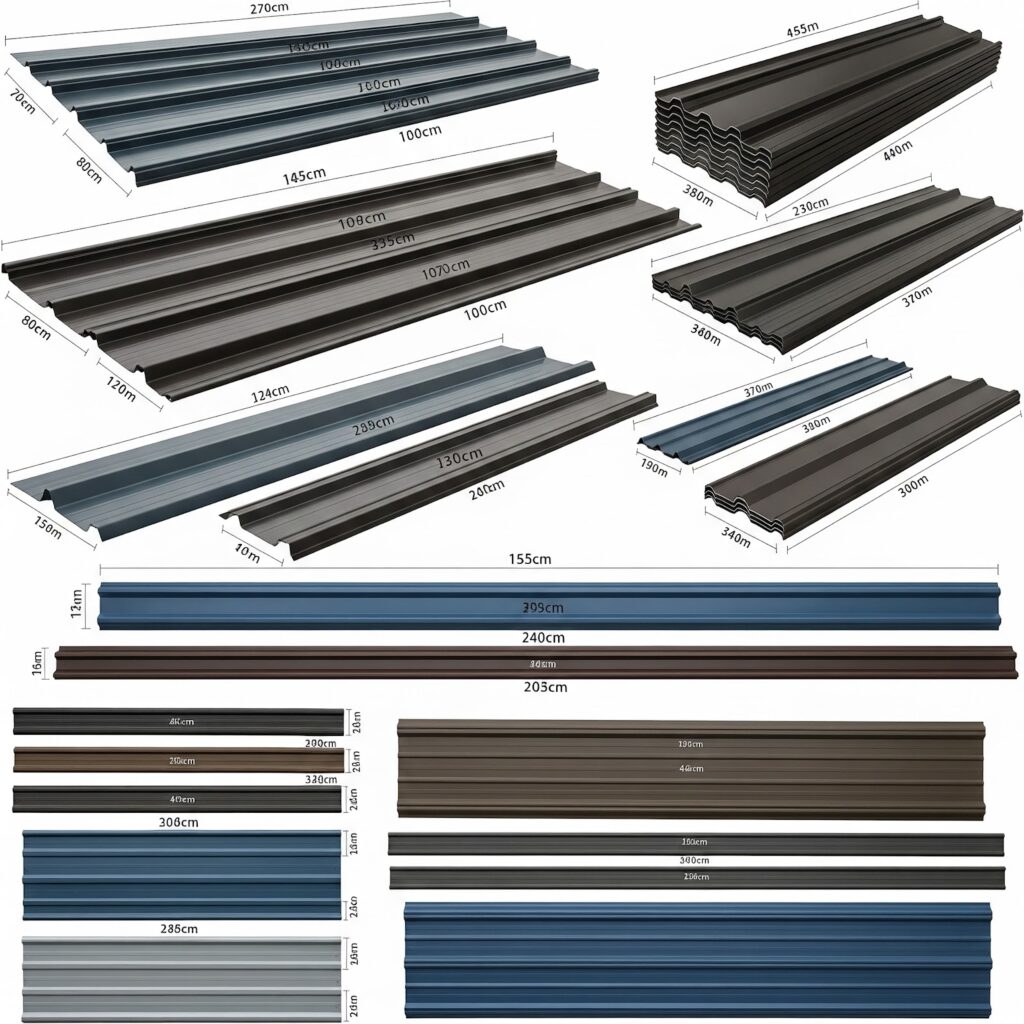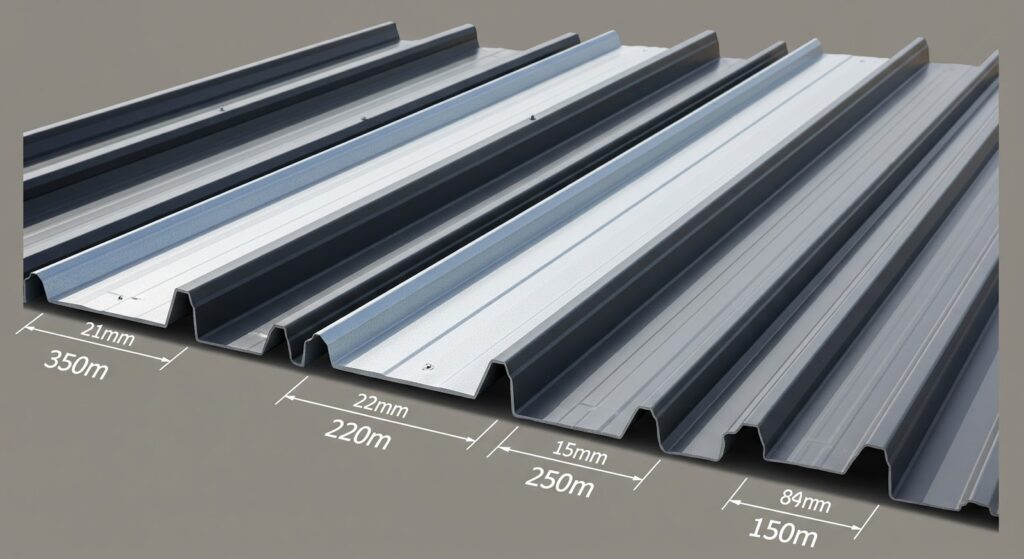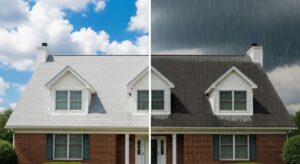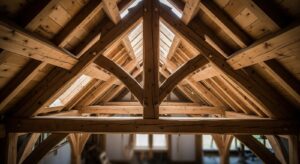When planning a metal roofing installation, one of the most important factors to consider is the metal roof panel sizes. The dimensions of your roofing panels affect both the overall appearance and performance of your roof. Getting the right size ensures a smooth, secure, and long-lasting installation while minimizing waste and unnecessary costs.
Whether you’re installing a new roof or replacing your old one, understanding the different metal roofing lengths, ribbed metal roofing, and metal roof panel dimensions is crucial for making informed decisions. In this detailed guide, we’ll explore the various sizes, types, and options for metal roof panels, and help you choose the best fit for your project.
What Are Metal Roof Panel Sizes?
Metal roof panel sizes refer to the dimensions of the individual sheets or panels that make up a metal roof. These panels come in a variety of widths, lengths, and thicknesses to accommodate different roofing styles, building designs, and environmental conditions.
Why Does Metal Roof Panel Size Matter?
Choosing the right metal roofing dimensions affects several factors:
Aesthetic Appeal: The size and style of your panels impact the visual aesthetics of your roof.
Installation Efficiency: The right panel size can reduce the number of seams and fasteners needed, making installation faster and more efficient.
Weather Resistance: Larger panels may reduce the potential for water leakage as they have fewer seams.
Cost: The size of the panels you choose will impact your material costs and overall project budget.
Common Metal Roof Panel Sizes and Dimensions
Standard Metal Roof Panel Sizes
When it comes to metal roof panel sizes, there are a few standard dimensions that most manufacturers follow. These sizes typically fall into these categories:
Width: The width of a metal roof panel typically ranges from 12 to 36 inches. The metal roof width affects how much coverage each panel provides.
Length: Metal roofing lengths can range anywhere from 6 feet to 40 feet. Longer panels result in fewer seams, which is beneficial for weather resistance and aesthetic appeal.
Thickness: Metal roof panel thickness is usually expressed in gauge, with common options being 22, 24, and 26 gauge. The lower the number, the thicker the panel.

Ribbed Metal Roofing Sizes
For a ribbed metal roof, which is a popular choice for commercial and industrial buildings, the panels usually feature raised ribs that help provide structural integrity. The size of these panels can vary depending on the type of ribbed metal used.
Ribbed Steel Panels: A common ribbed steel roof panel will typically have a width of around 36 inches with a length ranging from 6 to 40 feet.
Ribbed Aluminum Panels: Similar to their steel counterparts, ribbed aluminum panels are usually around 36 inches wide, but they may be lighter and more resistant to corrosion.
Galvanized Ribbed Steel Roof Panel
The galvanized ribbed steel roof panel is one of the most common types of ribbed steel roofing used for both residential and commercial applications. These panels are made of steel coated with a layer of zinc to prevent rust and corrosion.
Common Dimensions: These panels are typically 36 inches wide with lengths ranging from 6 feet to 40 feet, depending on your roof’s specifications.
Material and Durability: Galvanized steel offers excellent durability, resistance to weather, and a long lifespan, making it one of the most popular choices for metal roofing.
Understanding Ribbed Metal Roofing and Its Sizes
What is Ribbed Metal Roofing?
Ribbed metal roofing features a series of raised ridges or ribs that add strength and structure to the panels. These ribs provide a natural water drainage system and can help prevent damage from wind or snow accumulation. They are available in various materials, such as galvanized steel, aluminum, and copper.
Benefits of Ribbed Metal Panels
Strength: The raised ribs add structural strength to the panels, making them ideal for areas with heavy winds or snow loads.
Water Drainage: The ribbed design helps direct water flow off the roof, reducing the chance of water pooling or leaks.
Durability: Ribbed metal roofs are resistant to rust, corrosion, and extreme weather conditions.
Common Ribbed Metal Roofing Sizes
Ribbed panels typically have the following dimensions:
Width: 36 inches is the most common width for ribbed metal panels, although this can vary depending on the manufacturer.
Length: These panels can range from 6 feet to 40 feet in length, but custom sizes are available for unique roofing needs.
Thickness: Most ribbed metal roofing panels are available in gauges ranging from 22 to 26, with 22 gauge being the most durable for industrial applications.
How Wide Are Metal Roof Panels?
One of the most common questions homeowners and contractors ask is, “How wide is metal roofing?” The answer depends on the type of metal panel you’re using and its intended application.
Standard Width: Metal roof panels are generally between 12 to 36 inches wide. The width of the panels depends on the profile of the roofing system. For instance, ribbed metal panels often have a width of 36 inches, while more decorative or traditional styles may have narrower panels.
How Wide Are Metal Roofing Sheets? Metal roofing sheets are typically 36 inches wide, but some panels may have a different width based on the design and manufacturer specifications.
How to Choose the Right Metal Roof Panel Size for Your Project
Choosing the right metal roof panel size is crucial for a smooth and successful roofing installation. Here are some tips to guide you:
Consider Your Roof’s Pitch
The pitch or slope of your roof will influence the type of metal roof panel dimensions you choose. For roofs with a low slope, wider panels (36 inches) are often preferred to minimize seams and improve water drainage. For steeper roofs, narrower panels (12-24 inches) may be a better option.
Account for Aesthetic Preferences
The appearance of your roof can be impacted by the panel sizes you select. Wider panels, like ribbed metal siding, create a bold, modern look, while narrower panels offer a more traditional or textured appearance.
Climate Considerations
Heavy Snowfall Areas: In regions with heavy snowfall, ribbed steel panels may be a better option because the raised ribs help snow slide off more easily.
Windy Areas: If you live in a region that experiences strong winds, opting for thicker panels (22 gauge) with fewer seams will improve your roof’s resistance to wind damage.
Consider Custom Panel Sizes
If you have specific requirements or want to minimize seams, consider ordering custom panel sizes. Many roofing suppliers can create metal roofing lengths and ribbed metal roofing panels to suit your exact needs.
Where to Buy Metal Roofing Panels
Now that you have a better understanding of metal roof panel sizes, you may be wondering where to buy these panels. Here are a few options for purchasing metal roofing materials:
Local Roofing Suppliers
Your best option is often to start by checking with local roofing suppliers. They can offer a variety of panel sizes and materials, such as ribbed steel roof panels or galvanized ribbed steel roof panels. Plus, they can provide expert advice to help you select the right panel sizes for your roof.
Big-Box Stores
Major retailers like Home Depot, Lowe’s, and Menards sell metal roofing panels in standard sizes. You can often find ribbed metal panels, galvanized steel, and other materials at competitive prices.
Online Retailers
If you’re looking for convenience or more options, online retailers like Amazon or specialized metal roofing websites provide various metal roofing panels in different lengths, widths, and materials. Be sure to check shipping costs and delivery times if you’re purchasing large quantities.
Conclusion: Get the Right Metal Roof Panel Sizes for Your Roof
Choosing the best metal roof panel sizes for your project is essential for ensuring durability, weather resistance, and aesthetic appeal. Whether you’re opting for ribbed steel panels, galvanized roofing, or ribbed aluminum panels, make sure to select the right metal roofing lengths and metal roof panel dimensions for your needs.
By considering factors such as roof pitch, climate, and aesthetic preferences, you can choose the ideal panel size to enhance the performance of your roof while keeping costs manageable. Don’t forget to shop around for the best deals and consult with local suppliers to ensure you’re getting quality materials.
Ready to start your project? Explore your options for metal roof panel sizes and get the best materials for your roofing needs today! Whether you’re installing a new roof or upgrading your existing one, choosing the right panel size will ensure your metal roofing provides long-lasting protection and style.






